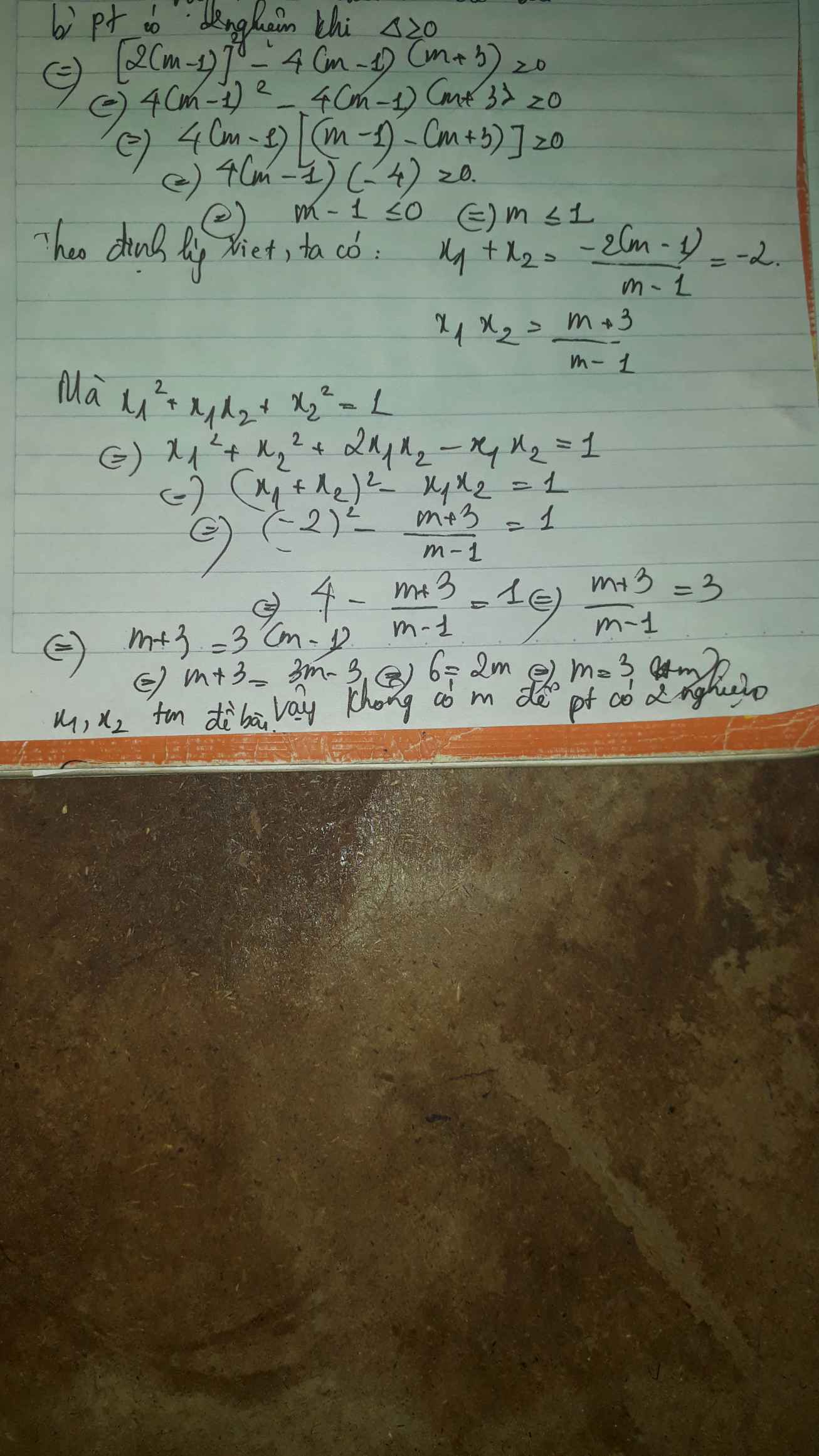Cho phương trình: \(x^3-m\left(x+2\right)+8=0\). Tìm m để phương trình có 3 nghiệm phân biệt x1, x2, x3
Hãy nhập câu hỏi của bạn vào đây, nếu là tài khoản VIP, bạn sẽ được ưu tiên trả lời.


\(x^3-x^2+2mx-2m=0\)
\(\Leftrightarrow x^2\left(x-1\right)+2m\left(x-1\right)=0\)
\(\Leftrightarrow\left(x-1\right)\left(x^2+2m\right)=0\)
\(\Leftrightarrow\left[{}\begin{matrix}x=1\\x^2=-2m\end{matrix}\right.\)
Để pt có 3 nghiệm \(\Rightarrow-2m>0\Rightarrow m< 0\)
a. Do vai trò 3 nghiệm như nhau, ko mất tính tổng quát giả sử \(x_1=1\) và \(x_2;x_3\) là nghiệm của \(x^2+2m=0\)
Để pt có 3 nghiệm pb \(\Rightarrow\left\{{}\begin{matrix}-2m>0\\-2m\ne1\end{matrix}\right.\) \(\Rightarrow\left\{{}\begin{matrix}m< 0\\m\ne-\dfrac{1}{2}\end{matrix}\right.\)
Khi đó: \(x_2+x_3=0\Rightarrow x_1+x_2+x_3=1\ne10\) với mọi m
\(\Rightarrow\) Không tồn tại m thỏa mãn yêu cầu
b.
Giả sử pt có 3 nghiệm, khi đó \(\left[{}\begin{matrix}x_2=-\sqrt{-2m}< 0< 1\\x_3=\sqrt{-2m}\end{matrix}\right.\)
\(\Rightarrow\) Luôn có 1 nghiệm của pt âm \(\Rightarrow\) không tồn tại m thỏa mãn
Em coi lại đề bài

\(\Delta'=\left(m+1\right)^2-\left(m^2+2m\right)=1>0\)
\(\Rightarrow\) Phương trình luôn có 2 nghiệm: \(\left\{{}\begin{matrix}x_1=m+1-1=m\\x_2=m+1+1=m+2\end{matrix}\right.\)
\(\left|x_1\right|=3\left|x_2\right|\Leftrightarrow\left|m\right|=3\left|m+2\right|\)
\(\Leftrightarrow\left[{}\begin{matrix}3m+6=-m\\3m+6=m\end{matrix}\right.\) \(\Rightarrow\left[{}\begin{matrix}m=-\dfrac{3}{2}\\m=-3\end{matrix}\right.\)

a, Thay \(m=-3\) vào \(\left(1\right)\)
\(x^2-2.\left(m-1\right)x-m-3=0\\ \Leftrightarrow x^2-2.\left(-3-1\right)x+3-3=0\\ \Leftrightarrow x^2+8x=0\\ \Leftrightarrow x\left(x+8\right)=0\\ \Leftrightarrow\left[{}\begin{matrix}x=0\\x=-8\end{matrix}\right.\)
Vậy với \(m=-3\) thì \(x=0;x=-8\)
b,
\(\Delta'=\left[-\left(m-1\right)\right]^2-1.\left(-m-3\right)\\ =m^2-2m+1+m+3\\ =m^2-m+4\)
phương trình có hai nghiệm phân biệt
\(\Delta'>0\\ m^2-m+4>0\\ \Rightarrow m^2-2.\dfrac{1}{2}m+\dfrac{1}{4}+\dfrac{7}{2}>0\\ \Leftrightarrow\left(m-\dfrac{1}{2}\right)^2+\dfrac{7}{2}>0\left(lđ\right)\)
\(\Rightarrow\forall m\)
Áp dụng hệ thức Vi ét :
\(\left\{{}\begin{matrix}x_1+x_2=2\left(m-1\right)\\x_1x_2=-m-3\end{matrix}\right.\)
\(\left(x_1-x_2\right)^2=4m^2-5\left(x_1+x_2\right)\\ \Leftrightarrow x_1^2+2x_1.x_2+x^2_2-4x_1x_2=4m^2-5\left(x_1+x_2\right)\\ \Leftrightarrow\left(x_1+x_2\right)^2-4x_1x_2=4m^2-5\left(x_1+x_2\right)\\ \Leftrightarrow\left(2.\left(m-1\right)\right)^2-4.\left(-m-3\right)=4m^2-5.\left(-m-3\right)\\ \Leftrightarrow4m^2-8m+4+4m+12-4m^2-5m-15=0\\ \Leftrightarrow-9m+1=0\\ \Leftrightarrow m=\dfrac{1}{9}\)
Vậy \(m=\dfrac{1}{9}\)
a.
Thế m = -3 vào phương trình (1) ta được:
\(x^2-2\left(-3-1\right)x-\left(-3\right)-3=0\)
\(\Leftrightarrow\) \(x^2+8x=0\)
\(\Leftrightarrow x\left(x+8\right)=0\\ \Rightarrow x_1=0,x_2=-8\)
b.
Để phương trình (1) có hai nghiệm phân biệt thì:
\(\Delta>0\\ \Leftrightarrow\left[-2\left(m-1\right)\right]^2-4.1.\left(-m-3\right)>0\)
\(\Leftrightarrow4.\left(m^2-2m+1\right)+4m+12>0\)
\(\Leftrightarrow4m^2-8m+4+4m+12>0\)
\(\Leftrightarrow4m^2-4m+16>0\)
\(\Leftrightarrow\left(2m\right)^2-4m+1+15>0\)
\(\Leftrightarrow\left(2m-1\right)^2+15>0\)
Vì \(\left(2m-1\right)^2\) luôn lớn hơn hoặc bằng 0 với mọi m nên phương trình (1) có nghiệm với mọi m.
Theo viét:
\(\left\{{}\begin{matrix}x_1+x_2=2m-2\\x_1x_2=-m-3\end{matrix}\right.\) (I)
có:
\(\left(x_1-x_2\right)^2=4m^2-5x_1+x_2\)
<=> \(x_1^2-2x_1x_2+x_2^2-4m^2+5x_1-x_2=0\)
<=> \(x_1^2-2x_1x_2+x_2^2+2x_1x_2-2x_1x_2-4m^2+5x_1-x_2=0\)
<=> \(\left(x_1+x_2\right)^2-4x_1x_2-4m^2+5x_1-x_2=0\)
<=> \(\left(2m-2\right)^2-4.\left(-m-3\right)-4m^2+5x_1-x_2=0\)
<=> \(4m^2-8m+4+4m+12-4m^2+5x_1-x_2=0\)
<=> \(-4m+16+5x_1-x_2=0\)
<=> \(5x_1-x_2=4m-16\) (II)
Từ (I) và (II) ta có:
\(\left\{{}\begin{matrix}5x_1-x_2=4m-16\left(2\right)\\x_1+x_2=2m-2\left(3\right)\\x_1x_2=-m-3\left(4\right)\end{matrix}\right.\)
Từ (2) ta có:
\(x_1=\dfrac{4m-16+x_2}{5}=\dfrac{4}{5}m-3,2+\dfrac{1}{5}x_2\) (x)
Thế (x) vào (3) được:
\(\dfrac{4}{5}m-3,2+\dfrac{1}{5}x_2+x_2=2m-2\)
<=> \(\dfrac{4}{5}m-3,2+\dfrac{1}{5}x_2+x_2-2m+2=0\)
<=> \(-1,2m-1,2+1,2x_2=0\)
<=> \(x_2=1,2m+1,2\) (xx)
Thế (xx) vào (3) được:
\(x_1+1,2m+1,2=2m-2\)
<=> \(x_1+1,2m+1,2-2m+2=0\)
<=> \(x_1-0,8m+3,2=0\)
<=> \(x_1=-3,2+0,8m\) (xxx)
Thế (xx) và (xxx) vào (4) được:
\(\left(-3,2+0,8m\right)\left(1,2m+1,2\right)=-m-3\)
<=> \(-3,84m-3,84+0,96m^2+0,96m+m+3=0\)
<=> \(0,96m^2-1,88m-0,84=0\)
\(\Delta=\left(-1,88\right)^2-4.0,96.\left(-0,84\right)=6,76\)
\(m_1=\dfrac{1,88+\sqrt{6,76}}{2.0,96}=\dfrac{7}{3}\left(nhận\right)\)
\(m_2=\dfrac{1,88-\sqrt{6,76}}{2.0,96}=-\dfrac{3}{8}\left(nhận\right)\)
T.Lam

\(\left\{{}\begin{matrix}x^2+2xy-3y^2=-4\left(1\right)\\2x^2+xy+4y^2=5\left(2\right)\end{matrix}\right.\)\(với\)\(y=0\Rightarrow hpt\Leftrightarrow\left\{{}\begin{matrix}x^2=-4\\2x^2=5\end{matrix}\right.\)\(\left(loại\right)\)
\(y\ne0\) \(đặt:x=t.y\Rightarrow hpt\Leftrightarrow\left\{{}\begin{matrix}t^2y^2+2ty^2-3y^2=-4\left(3\right)\\2t^2y^2+ty^2+4y^2=5\left(4\right)\end{matrix}\right.\)
\(\Leftrightarrow5t^2y^2+10ty^2-15y^2=-8t^2y^2-4ty^2-16y^2\)
\(\Leftrightarrow13t^2y^2+14ty^2+y^2=0\)
\(\Leftrightarrow13t^2+14t+1=0\Leftrightarrow\left[{}\begin{matrix}t=-\dfrac{1}{13}\\t=-1\end{matrix}\right.\)\(\Leftrightarrow\left[{}\begin{matrix}x=-\dfrac{1}{13}y\left(5\right)\\x=-y\left(6\right)\end{matrix}\right.\)
\(thay\left(5\right)và\left(6\right)\) \(lên\left(1\right)hoặc\left(2\right)\Rightarrow\left(x;y\right)=\left\{\left(1;-1\right);\left(-1;1\right);\left(-\dfrac{1}{\sqrt{133}};\dfrac{13}{\sqrt{133}}\right)\right\}\)
\(pt:x^4-4x^3+x^2+6x+m+2=0\)
\(\Leftrightarrow x^4-4x^3+4x^2-3x^2+6x+m+2=0\)
\(\Leftrightarrow\left(x^2-2x\right)^2-3\left(x^2-2x\right)+m+2=0\left(1\right)\)
\(đặt:x^2-2x=t\ge-1\)
\(\Rightarrow\left(1\right)\Leftrightarrow t^2-3t=-m-2\)
\(xét:f\left(t\right)=t^2-3t\) \(trên[-1;+\text{∞})\) \(và:y=-m-2\)
\(\Rightarrow f\left(-1\right)=4\)
\(f\left(-\dfrac{b}{2a}\right)=-\dfrac{9}{4}\)
\(\left(1\right)\) \(có\) \(3\) \(ngo\) \(pb\Leftrightarrow-m-2=4\Leftrightarrow m=-6\)

b) phương trình có 2 nghiệm \(\Leftrightarrow\Delta'\ge0\)
\(\Leftrightarrow\left(m-1\right)^2-\left(m-1\right)\left(m+3\right)\ge0\)
\(\Leftrightarrow m^2-2m+1-m^2-3m+m+3\ge0\)
\(\Leftrightarrow-4m+4\ge0\)
\(\Leftrightarrow m\le1\)
Ta có: \(x_1^2+x_1x_2+x_2^2=1\)
\(\Leftrightarrow\left(x_1+x_2\right)^2-2x_1x_2=1\)
Theo viet: \(\left\{{}\begin{matrix}x_1+x_2=-\dfrac{b}{a}=2\left(m-1\right)\\x_1x_2=\dfrac{c}{a}=m+3\end{matrix}\right.\)
\(\Leftrightarrow\left[-2\left(m-1\right)^2\right]-2\left(m+3\right)=1\)
\(\Leftrightarrow4m^2-8m+4-2m-6-1=0\)
\(\Leftrightarrow4m^2-10m-3=0\)
\(\Leftrightarrow\left[{}\begin{matrix}m_1=\dfrac{5+\sqrt{37}}{4}\left(ktm\right)\\m_2=\dfrac{5-\sqrt{37}}{4}\left(tm\right)\end{matrix}\right.\Rightarrow m=\dfrac{5-\sqrt{37}}{4}\)

Ta có: \(\Delta=4m^2+4m-11\)
Để phương trình có 2 nghiệm phân biệt \(\Leftrightarrow4m^2+4m-11>0\)
Theo Vi-ét, ta có: \(\left\{{}\begin{matrix}x_1+x_2=2m+3\\x_1x_2=2m+5\end{matrix}\right.\)
Để phương trình có 2 nghiệm dương phân biệt
\(\Leftrightarrow\left\{{}\begin{matrix}4m^2+4m-11>0\\2m+3>0\\2m+5>0\end{matrix}\right.\) \(\Leftrightarrow\left\{{}\begin{matrix}\left[{}\begin{matrix}m< \dfrac{-1-2\sqrt{3}}{2}\\m>\dfrac{-1+2\sqrt{3}}{2}\end{matrix}\right.\\m>-\dfrac{3}{2}\\m>-\dfrac{5}{2}\end{matrix}\right.\) \(\Leftrightarrow m>\dfrac{-1+2\sqrt{3}}{2}\)
Mặt khác: \(\dfrac{1}{\sqrt{x_1}}+\dfrac{1}{\sqrt{x_2}}=\dfrac{4}{3}\)
\(\Rightarrow\dfrac{x_1+x_2+2\sqrt{x_1x_2}}{x_1x_2}=\dfrac{16}{9}\) \(\Rightarrow\dfrac{2m+3+2\sqrt{2m+5}}{2m+5}=\dfrac{16}{9}\)
\(\Rightarrow18m+27+18\sqrt{2m+5}=32m+80\)
\(\Leftrightarrow14m-53=18\sqrt{2m+5}\)
\(\Rightarrow\) ...

Lời giải:
Xin chỉnh sửa lại chút, tìm $k$, chứ không phải tìm $m$.
PT $\Leftrightarrow x^2-(6k-2)=0\Leftrightarrow x^2=6k-2$
Để pt có 2 nghiệm phân biệt thì $6k-2>0\Leftrightarrow k>\frac{1}{3}$
Khi đó:
$x_1=\sqrt{6k-2}$ và $x_2=-\sqrt{6k-2}$
Để $3x_1-x_2=2$
$\Leftrightarrow 3\sqrt{6k-2}+\sqrt{6k-2}=2$
$\Leftrightarrow \sqrt{6k-2}=\frac{1}{2}\Rightarrow k=\frac{3}{8}$

Trường hợp 1: m=10
Phương trình sẽ là -40x+6=0
hay x=3/20
=>m=10 sẽ thỏa mãn trường hợp a
Trường hợp 2: m<>10
\(\Delta=\left(-4m\right)^2-4\left(m-10\right)\left(m-4\right)\)
\(=16m^2-4\left(m^2-14m+40\right)\)
\(=16m^2-4m^2+56m-160\)
\(=12m^2+56m-160\)
\(=4\left(3m^2+14m-40\right)\)
\(=4\left(3m^2-6m+20m-40\right)\)
\(=4\left(m-2\right)\left(3m+20\right)\)
a: Để phương trình có nghiệm thì (m-2)(3m+20)>=0
=>m>=2 hoặc m<=-20/3
b: Để phương trình có hai nghiệm phân biệt đều dương thì
\(\left\{{}\begin{matrix}\left(m-2\right)\left(3m+20\right)>0\\\dfrac{4m}{m-10}>0\\\dfrac{m-4}{m-10}>0\end{matrix}\right.\Rightarrow\left\{{}\begin{matrix}\left(m-2\right)\left(3m+20\right)>0\\m\in\left(-\infty;0\right)\cup\left(10;+\infty\right)\\m\in\left(-\infty;4\right)\cup\left(10;+\infty\right)\end{matrix}\right.\)
\(\Leftrightarrow m\in\left(-\infty;-\dfrac{20}{3}\right)\cup\left(10;+\infty\right)\)

\(x^3+8-m\left(x+2\right)=0\)
\(\Leftrightarrow\left(x+2\right)\left(x^2-2x+4\right)-m\left(x+2\right)=0\)
\(\Leftrightarrow\left(x+2\right)\left(x^2-2x-m+4\right)=0\)
\(\Leftrightarrow\left[{}\begin{matrix}x=-2\\x^2-2x-m+4=0\left(1\right)\end{matrix}\right.\)
Phương trình đã cho có 3 nghiệm pb khi và chỉ khi (1) có 2 nghiệm pb khác -2
\(\Leftrightarrow\left\{{}\begin{matrix}\left(-2\right)^2-2.\left(-2\right)-m+4\ne0\\\Delta'=1-\left(-m+4\right)>0\end{matrix}\right.\)
\(\Leftrightarrow\left\{{}\begin{matrix}m\ne12\\m>3\end{matrix}\right.\)